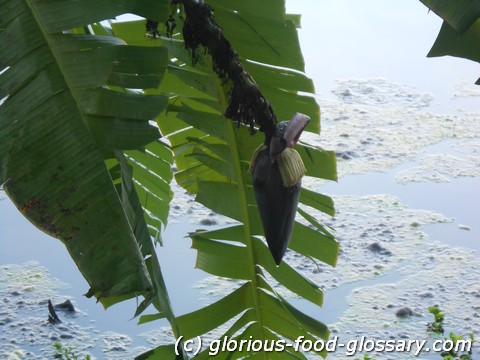Deutsch: Bananenblütenherz / Español: Corazón de Banana / Português: Coração de Banana / Français: Cœur de Bananier / Italiano: Cuore di Banana
Puso ng Saging, also known as banana blossom or banana heart, is a tear-shaped, purple-skinned flower that hangs at the end of banana clusters. In the culinary context, it is a versatile ingredient used in many Southeast Asian cuisines, including Filipino, Thai, and Vietnamese. The banana blossom is valued for its meaty texture and ability to absorb flavors, making it a popular ingredient in salads, curries, and vegan or vegetarian dishes as a substitute for meat or fish.
Description
The Puso ng Saging has a slightly bitter and astringent taste, which can be mitigated by preparing it properly, often involving soaking in water with a bit of vinegar or lemon juice. The outer purple leaves (bracts) are peeled away to reveal the paler, tender inner heart, which is then sliced and cooked. This part of the banana plant is rich in vitamins and minerals, making it a nutritious addition to various dishes.
Application Areas
Puso ng Saging is widely used in traditional dishes across Southeast Asia. In the Philippines, it is commonly cooked in coconut milk with pork or seafood and spices to make a rich, flavorful stew. It is also used as an ingredient in salads, where it's boiled and mixed with other vegetables, or as a meat substitute in vegan dishes because of its texture. In other Southeast Asian cuisines, it might be found in curries, soups, and fried dishes.
Well-Known Examples
A famous Filipino dish using Puso ng Saging is "Ginataang Puso ng Saging," where the banana blossom is cooked in coconut milk, chili, garlic, and sometimes with shrimp or pork. Another example is the Thai "Yam Hua Plee," a spicy salad made with banana blossoms. These dishes showcase the versatility and cultural significance of Puso ng Saging in Southeast Asian cuisine.
Treatment and Risks
While Puso ng Saging is nutritious, offering fiber, potassium, vitamins A, C, E, and other minerals, its preparation requires some knowledge to reduce its natural bitterness. Soaking in water with a bit of salt or acidic substance like vinegar or lemon juice not only mitigates the bitterness but also prevents discoloration. There are no significant health risks associated with Puso ng Saging, making it a safe and healthy choice for most diets.
Recipes
Simple Ginataang Puso ng Saging Recipe:
Ingredients:
- 1 Puso ng Saging (banana blossom), cleaned and sliced
- 2 cups coconut milk
- 2 tablespoons vinegar
- 1 onion, sliced
- 3 cloves garlic, minced
- 1 tablespoon ginger, julienned
- 2 green chili peppers, sliced
- Salt and pepper to taste
- Optional: shrimp or pork slices
Instructions:
- Prepare the banana blossom by removing the outer layers until you reach the softer heart. Slice and soak in water mixed with vinegar for about 10 minutes to remove bitterness.
- Drain and squeeze the banana blossom to remove excess water.
- In a pan, sauté garlic, onion, and ginger until aromatic.
- Add the banana blossom and optional pork or shrimp. Cook for a few minutes.
- Pour in the coconut milk and bring to a simmer. Add the vinegar and chili peppers. Season with salt and pepper.
- Cook until the banana blossom is tender and the sauce thickens slightly.
- Serve hot with rice.
Similar Terms or Synonyms
Banana blossom is also known as banana heart, banana flower, and in scientific contexts, it is referred to based on its species, such as Musa acuminata or Musa balbisiana.
Summary
Puso ng Saging is not just an exotic ingredient but a staple in Southeast Asian kitchens, celebrated for its versatility, nutritional value, and distinctive taste. Whether featured in a hearty coconut stew, a vibrant salad, or as a meat alternative, the banana blossom brings a unique flavor and texture to the table, embodying the rich culinary traditions of the region.
--


